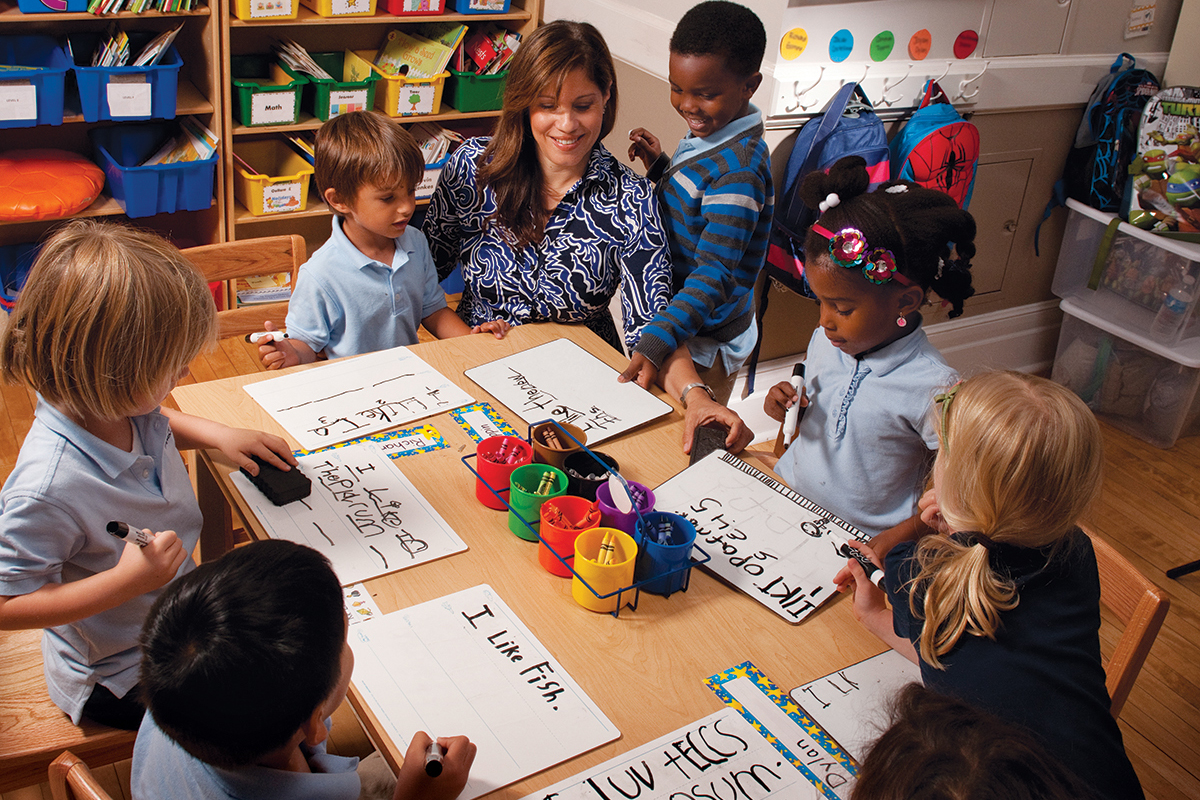Early childhood education lays the groundwork for a child’s future learning and development. Research highlights that the early years are vital for cognitive, emotional, and social growth. But what defines an effective early childhood education curriculum? A successful curriculum engages young learners while addressing their unique developmental needs. This article explores the key components of a curriculum that fosters holistic development in children.
Key Elements of an Effective Early Childhood Education Curriculum
Age-Appropriate Learning Goals An effective curriculum is tailored to the developmental stage of the child. Each child progresses at their own pace, so it’s important to set achievable goals for each age group. Gradually introducing new concepts ensures the curriculum aligns with what children can grasp cognitively, emotionally, and physically.
Child-Centered Learning Approaches Children are naturally curious, and a child-centered curriculum taps into this by allowing them to take an active role in their learning. In this model, children choose activities that interest them, fostering engagement, independence, and confidence as they learn at their own pace.
Balance Between Play and Academic Instruction While academic learning is important, play is just as critical in early childhood education. Play helps develop social skills, problem-solving abilities, and emotional intelligence. A well-rounded curriculum combines structured learning with ample opportunities for imaginative and free play.
Flexibility and Adaptability Children learn in different ways. A flexible curriculum that adapts to individual needs ensures that every child can thrive. Teachers should have the freedom to adjust lesson plans based on student progress and interests.
The Role of Developmental Milestones in Curriculum Design
Understanding Cognitive Development Stages As children grow, their cognitive abilities change. A curriculum designed around these developmental stages, such as sensory exploration for toddlers or simple problem-solving for preschoolers, supports intellectual growth.
Social and Emotional Development Considerations An effective curriculum doesn’t just focus on academics; it also addresses social and emotional development. Teaching children to cooperate, share, and manage their emotions builds a foundation for healthy relationships.
Physical Development and Motor Skills Physical activities, like drawing, cutting, or outdoor play, help develop fine and gross motor skills. A curriculum that incorporates these activities promotes physical development and body awareness.
Incorporating Play-Based Learning
The Importance of Play in Early Learning Play is essential for young children’s learning. It nurtures creativity, social connections, and problem-solving skills. A strong curriculum integrates play throughout the day to support overall growth.
Structured vs. Unstructured Play Structured play has specific goals, like puzzles or building blocks, while unstructured play allows for free exploration. A balance of both types of play encourages focused learning and creative freedom.
Examples of Play-Based Activities Activities like role-playing, outdoor games, and sensory stations engage children in hands-on learning. These activities promote critical thinking, collaboration, and self-expression.
Creating an Inclusive Curriculum
Culturally Responsive Teaching An inclusive curriculum reflects the diverse backgrounds of its students, making every child feel valued. This can be done by incorporating books, songs, and activities from various cultural traditions.
Supporting Children with Diverse Needs An effective curriculum also provides support for children with special needs, ensuring they have equal access to education. This may involve adaptive materials, one-on-one support, or specialized activities.
Gender-Neutral and Bias-Free Content A bias-free curriculum avoids gender stereotypes, allowing children to explore a range of interests without limitations. Encouraging all children to engage in diverse activities, whether it’s storytelling or science, fosters a more equitable environment.
Parental Involvement in Early Childhood Education
Building Strong Home-School Connections Parents play a key role in their child’s education. Strong communication between teachers and parents ensures that learning is supported at home. Regular updates keep parents engaged and involved.
Engaging Parents in the Learning Process Inviting parents to participate in classroom activities or providing at-home learning resources ensures they are active partners in their child’s education.
Parental Feedback and Curriculum Improvement Gathering feedback from parents offers valuable insights into a child’s experience, helping educators refine the curriculum to better meet students’ needs.
Use of Technology in Early Childhood Education
Age-Appropriate Technology Integration Technology, when used properly, can enhance learning. Educational apps, interactive storybooks, and child-friendly websites can introduce new concepts in an engaging way. However, screen time should be carefully managed.
Benefits and Challenges of Digital Tools While digital tools offer educational benefits, challenges like overexposure and screen dependency need to be considered. A balanced curriculum uses technology as a supplement, not a replacement for traditional learning.
Encouraging Responsible Tech Usage It’s important to teach children responsible technology use from an early age. Setting limits on screen time and encouraging other activities helps maintain a healthy relationship with technology.
Teacher Training and Curriculum Delivery
Professional Development for Early Childhood Educators A curriculum is only as effective as the educators delivering it. Continuous professional development ensures that teachers stay updated on the latest teaching strategies in early childhood education.
Classroom Management Techniques Creating a positive learning environment requires effective classroom management. Teachers should be skilled in setting boundaries, conflict resolution, and maintaining a respectful classroom culture.
Ongoing Assessment of Teacher Performance Regular evaluations of teaching methods help educators refine their techniques and ensure that the curriculum is being delivered in the most effective way.
Assessment and Feedback in Early Childhood Education
Observational Assessments In early childhood education, observational assessments are often used instead of standardized tests. These assessments provide a more comprehensive view of a child’s development.
Individualized Learning Plans (ILPs) ILPs allow teachers to tailor the curriculum to each child’s needs, helping to close learning gaps and build on strengths.
Providing Feedback to Support Growth Constructive feedback, through positive reinforcement and gentle guidance, supports children’s development and helps them overcome challenges.
Integrating Social-Emotional Learning (SEL)
Importance of SEL in Early Childhood Social-emotional learning (SEL) teaches children to manage their emotions, build empathy, and set goals. It is crucial for forming healthy relationships and achieving long-term success.
Strategies for Teaching Empathy and Cooperation Group activities such as team games help children develop empathy and cooperation. SEL can also be fostered through role-playing and discussions.
Emotional Regulation Through Classroom Activities Mindfulness, storytelling, and art can help children learn to regulate their emotions, enabling them to navigate social situations more effectively.
Language and Literacy Development
Fostering Early Reading Skills Introducing books and storytelling from a young age helps build early literacy. A curriculum that promotes reading, phonics, and verbal expression supports language development.
Building Vocabulary and Communication Conversation, singing, and reading aloud enhance children’s vocabulary and communication skills.
Incorporating Storytelling and Interactive Reading Interactive reading engages children in predicting outcomes and discussing stories, enhancing their comprehension.
Encouraging Critical Thinking and Problem-Solving
Stimulating Curiosity and Inquiry A good curriculum encourages children to ask questions and explore, fostering a love of learning and critical thinking.
Hands-On Activities for Critical Thinking Hands-on tasks like science experiments or puzzle-solving promote independent thinking and active learning.
Promoting Independent Thought By allowing children to solve problems on their own, the curriculum builds their resilience and critical thinking skills.
Addressing Nutrition and Physical Activity in the Curriculum
Nutrition Education for Young Learners Teaching children about healthy eating habits early on promotes long-term well-being. A curriculum that includes lessons on nutrition helps children understand the importance of a balanced diet.
Promoting Healthy Physical Activity Physical activity, such as dance or sports, is essential for healthy development. Incorporating movement into the curriculum keeps children active and engaged.
Combining Movement with Learning Activities that integrate learning with movement, like counting games paired with actions, make lessons both fun and educational.
The Importance of a Safe and Supportive Learning Environment
Classroom Design for Safety and Engagement A well-organized classroom, with accessible materials, promotes independence and creates a safe space for exploration and learning.
Emotional Support and Positive Reinforcement Providing emotional support and using positive reinforcement helps build children’s self-esteem and motivation.
Building a Sense of Belonging Fostering a classroom community where children feel they belong encourages engagement and builds strong social connections.
Conclusion
An effective early childhood education curriculum promotes academic, social, emotional, and physical development. By creating a nurturing environment and offering a balanced, adaptable curriculum, children are given the tools they need for lifelong success. Meeting the diverse needs of each child supports well-rounded growth and prepares them for future learning.
FAQs
- What are the goals of an early childhood education curriculum? The primary goals are to support holistic development, encourage social-emotional growth, and prepare children for lifelong learning.
- How can parents support their child’s learning at home? Parents can help by reading together, encouraging play, and staying in touch with teachers.
- Why is play so crucial in early childhood education? Play supports cognitive, social, and emotional development, making it a key element of early learning.
- How can teachers create an inclusive curriculum? Teachers can incorporate culturally diverse materials, support children with special needs, and ensure a bias-free environment.
- What role does technology play in early childhood education? When used appropriately, technology can enhance learning, but it should be used in moderation to ensure a balanced experience.





